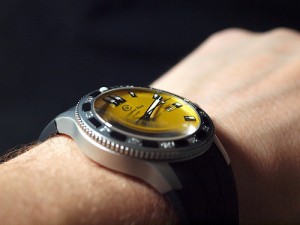
Remember the analog wristwatch?
Thanks to the smartphone, I stopped wearing a wristwatch regularly many years ago. Once wristwatches were a utility for timekeeping, but now manufacturers have concentrated their presence in the luxury jewelry category. There also are some niche categories where precise timekeeping is critical. I’m a serious sailor and rely on a high quality wristwatch for navigation.
Now anticipation is growing over potential smartwatch releases from Apple, Samsung and others. I envision benefits of convenience and portability, though I’m skeptical of the baggage of yet another portable electronic device. As with smart glasses, I dread more delicate silicon chips, more software to set up and maintain, more batteries to charge, more toxic waste to throw into landfills, and another statement of one’s dorkiness.
With the dominance of smartphones as timekeepers and growing excitement about smartwatches, now is an excellent time to rediscover the benefits and precision of analog wristwatches for doing their core job: simply telling time.
Smartphones (and presumably smartwatches) do a sufficient, albeit substandard, job of telling time. Most notably, it is difficult (for people like me) to look at a smartphone to view the time and avoid Facebook, Twitter, caller ID, text and email alerts. The screen and interactivity of the smartphone is distracting and sometimes anxiety-inducing. I’m sure I could rig my smartphone to be more focused, but the temptation to access and respond to stimuli is addictive. These factors degrade the smartphone’s performance as a timekeeping utility, and underscore the beauty of the wristwatch.
When I use a watch, I also enjoy not having to hit the power button to see the time appear. A good analogy is a paper book (or traditional Kindle) versus a tablet. A book or Kindle creates an unparalleled, focused experience, while a tablet lends itself to interruption and distraction. My adoption of a wristwatch for my current month-long sailing trip proves this.
Of course, smartphones don’t stand up well to moisture, whether from swimming, showering or simply washing your hands, and they can be affected by sudden shocks. Their displays crack easily and often.
Smartphones are also power-hungry. At best, you’re a slave to charging your smartphone, which enables you to tell time. At worst, you run out of power and you can’t tell time. Conversely, simple LCD watches can go for years on a single battery.
And for those paranoid of the NSA, traditional wristwatches enable you to tell time without being tracked.
I embrace technology and am an early adopter. But I also embrace utility and experience. For these reasons, I prefer an old-fashioned wristwatch. The nostalgia and fashion value are plusses, too.
Smartphones are here to stay, and smartwatches may catch on, but I predict a resurgence of the traditional wristwatch.
Are wrist watches are not dead? How do you keep time?
Let me know in the comment box below.
This essay also appeared in MediaPost. Photo by jasonpitsch.

Hey Max – Check out my friend Ave Rose’s work… She takes classic wristwatches apart, and puts them back together as pieces of art. Awesome stuff: http://www.watchbotworld.com/wearable_art
That’s pretty awesome. That’s a new take on watches as luxury jewelry. I understand the “taking apart as art” aspect, but it would be cool if she could offer her art embedded in real, working watches as well (for boring, practical people like me).
It’s much easier, and more eloquent, to look at one’s wristwatch to check the time than to reach in a pocket, fumble with your phone, and push a button to only have a digital readout of the time shown. I much prefer simply raising my wrist to read the time on my analog Movado. ” The nostalgia and fashion value are pluses.” Thanks for a great article!
I still think analog pocket watches are relevant as well.
Sorry, was that irony, or are you serious?